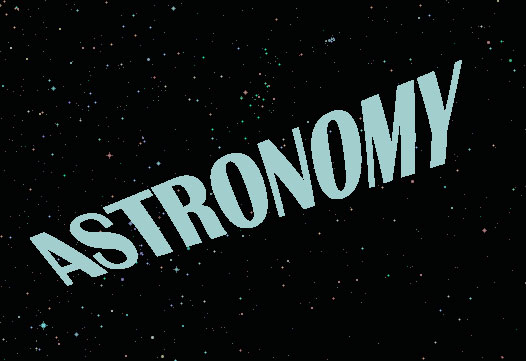 |
| Artist's depiction of a binary system |
Binary stars are stellar systems in which two stars orbit their common center of mass. When observed by the unaided eye from a far enough distance away, these dual-star systems appear to be a single point of light and thus can easily be mistaken for individual stars like our own Sun. Interestingly enough, these types of systems are not a rarity in the Universe. It is thought that nearly half of the stars that are visible from Earth are part of a multiple star system. Notable examples of binary systems include our closest stellar neighbor, Alpha Centauri, and the twin suns, Tatoo I and Tatoo II, that are orbited by Tatooine, homeworld of Anakin and Luke Skywalker.
 |
| Tatoo I and Tatoo II |
While these binary systems are not as easily observed from Earth as they are from the surface of Tatooine, the students of Astronomy 16 set out to observe the NSVS01031772 system using the Clay Telescope on top of the Science Center. This particular binary system is a low-mass system, which makes it particularly interesting to observational astronomers because few low-mass systems have been discovered because, while they are predicted to be extremely common, their low brightness makes them difficult to detect. The properties and observations of this system were first laid out in a paper published in 2006 by López-Morales, et al. entitled "NSVS01031772: A New \(0.50\:+\:0.54\: M_{\odot}\) Detached Eclipsing Binary. The purpose of our lab was to gather information about the binary NSVS01031772 system by observing its eclipse and then subsequently calculate the stellar radii, masses, and separation between the two stars using our data. Since our data, being collected in Cambridge by novice astronomers was expected to be inferior to the data collected by the researchers, we could use their scientific paper to check our results.
The key source of our information comes from the fact that we observed an eclipsing binary system. An eclipse in a binary system happens when one of the stars passes in front of the other, thus blocking some of the flux that would have been detected by our telescope on Earth. When we observe a star using a sophisticated telescope, the telescope can produce a "light curve" that shows how much flux it receives from the observed object over time. In the case of an eclipsing binary, this flux is initially constant. This baseline flux occurs when the full receivable flux from both stars is received by the telescope on Earth. However, since the stars are in orbit around their mutual center of mass, one will eventually pass in front of the other and eclipse it. When this eclipse takes place, the light curve dips down as the flux decreases due to one star blocking the emitted flux of the other. When the smaller star in the system passes in front of the larger star, the dip is greater than when the larger star completely blocks the smaller star.

Methods
In order to calculate the radii, masses, and separation of the two stars, we can use many of the equations that we developed in class, especially in the exoplanet worksheet. Here are the equations that we can use when the system's center of mass is defined as zero.
\[\frac{-M_{1}a_{1}\:+\:M_{2}a_{2}}{M_{1}\:+\:M_{2}}\:=\:0\]
\[-M_{1}a_{1}\:+\:M_{2}a_{2}\:=\:0\]
\[\frac{M_{1}}{M_{2}}\:=\:\frac{a_{2}}{a_{1}}\]
This gives us the relationship between mass and the semi-major axis of the two stars.
To find the semi-major axises, we use the relationship between period and velocity:
\[P\:=\:\frac{2\pi a}{V}\:\rightarrow\:V\:=\:\frac{2\pi a}{P}\:\rightarrow\:a\:=\:\frac{VP}{2\pi}\]
\[a_{1}\:=\:\frac{V_{1}P}{2\pi}\]
\[a_{2}\:=\:\frac{V_{2}P}{2\pi}\]
Then using Kepler's Third Law, we can solve for the masses of the stars.
\[P^{2}\:=\:\frac{4\pi^{2} a^{3}}{G(M_{1}\:+\:M_{2})}\]
\[(M_{1}\:+\:M_{2})\:=\:\frac{4\pi^{2} a^{3}}{GP^{2}}\]
We also know that:
\[\frac{M_{1}}{M_{2}}\:=\:\frac{a_{2}}{a_{1}}\]
Thus:
\[M_{1}\:=\:\frac{M_{2}a_{2}}{a_{1}}\]
\[M_{2}(1\:+\:\frac{a_{2}}{a_{1}})\:=\:\frac{4\pi^{2} a^{3}}{GP^{2}}\]
This means that:
\[M_{1}\:=\:\frac{4\pi^{2} a^{3}}{GP^{2}(1\:+\:\frac{a_{2}}{a_{1}})}\:\times\:\frac{a_{2}}{a_{1}}\]
\[M_{2}\:=\:\frac{4\pi^{2} a^{3}}{GP^{2}(1\:+\:\frac{a_{2}}{a_{1}})}\]
Finally, in order to calculate the radius of the two stars, we need to use the method that we employed in our work with exoplanets. That is, we had to calculate the observed change in flux when one object passes in front of another and then use that to calculate the radius of each object. We know that luminosity is equal to Flux times the surface area of the star. This can be written as:
\[L\:=\:F\:\times\:A\]
\[F\:=\frac{L}{A}\]
We can describe the depth of our transit as the fractional difference in flux that occurs when the primary transit takes place, that is when the smaller star passes in front of the :
\[\frac{F_{initial}-F_{transit}}{F_{initial}}\:=\:\frac{(F_{1}\:+\:F_{2})-((F_{1}-F_{2})\:+\:F_{2})}{(F_{1}\:+\:F_{2})}\]
\[\frac{F_{2}}{F_{1}\:+\:F_{2}}\]
We know from class that this can be simplified to:
\[Depth\:=\:\frac{R_{2}^{2}}{R_{1}^{2}\:+\:R_{2}^{2}}\]
We also know that the duration of the primary transit is the time it takes for the smaller star to completely cross the diameter of the larger star, thus we know that:
\[t\:=\:\frac{2\pi R_{1}}{V_{2}}\]
\[R_{1}\:=\:\frac{V_{2}t}{2\pi}\]
Knowing the radius of the larger star, we can then substitute into the equation for the transit depth to solve for the radius of the second star.
Data and Observations
The Astronomy 16 class collected the data for this lab using the Clay Telescope, located on top of Harvard's Science Center. In total, we took 1004 images of our system. We used the red filter so we could best offset the urban conditions that detract from the clarity of our data collection. The data that we collected about the flux of the system was then normalized and folded so that all of the data from different nights could be recorded on the same graph. This graph, our light curve, is shown here:
As you can see from our light curve, the depth of the transit was about 0.7 and the duration of the transit was about 1.5 hours. These two values will be useful in our subsequent calculations.
Using the Radial Velocity Plot from the López-Morales, et al. paper, we can determine the radial velocity of the objects which will also be useful in our calculations.
The squares refer to the value of \(V_{2}\) and the circles refer to the value of \(V_{1}\).
From this we see that the max value for \(V_{2}\) is about \(1.8\:\times\:10^{2}\:km/s\) and the max value for \(V_{1}\) is about \(1.4\:\times\:10^{2} km/s\).
Analysis and Results
Before we begin to calculate, let's take a look at the values that we know:
From the light curve we know that:
Depth of Transit = 0.7
Time of transit = 1.5hrs = \(5.4\:\times\:10^{3} s\)
From the scientific paper we know:
\[V_{1}\:=\:1.4\:\times\:10^{7}cm/s\]
\[V_{2}\:=\:1.8\:\times\:10^{7}cm/s\]
\[P\:=\:8.83\:hrs\:=\:3.2\:\times\:10^{4}s\]
We can then use that data to find out the separation between the two stars.
\[a_{1}\:=\:\frac{V_{1}P}{2\pi}\:=\:\frac{1.4\:\times\:10^{7}(3.2\:\times\:10^{4}}{2\pi}\]
\[a_{1}\:=\:7\:\times\:10^{10}\:cm\]
\[a_{2}\:=\:\frac{V_{2}P}{2\pi}\:=\:\frac{1.8\:\times\:10^{7}(3.2\:\times\:10^{4}}{2\pi}\]
\[a_{2}\:=\:9.2\:\times\:10^{10}\:cm\]
\[a\:=\:a_{1}\:+\:a_{2}\:=\:1.62\:\times\:10^{11}\:cm\]
Now that we know \(a_{1}\) and \(a_{2}\), we can calculate the masses of the two stars:
\[M_{2}\:=\:\frac{4\pi^{2} a^{3}}{GP^{2}}\]
\[M_{2}\:=\:\frac{4\pi^{2} (1.62\:\times\:10^{11})^{3}}{6.67\:\times\:10^{-8}(3.2\:\times\:10^{4})^{2}}\]
\[M_{2}\:\approx\:1\:\times\:10^{33}g\:=\:.537\:M_{\odot}\]
\[M_{1}\:=\:M_{2}\:\times\:\frac{a_{2}}{a_{1}}\:=\:0.7 M_{\odot}\]
Finally, we just need to calculate the radii of the two stars. We know that:
\[R_{1}\:=\:\frac{V_{2}t}{2\pi}\]
\[R_{1}\:=\:\frac{1.8\:\times\:10^{7}\:\times\:5400s}{6.28}\]
\[R_{1}\:=\:1.55\:\times\:10^{10} cm\:=\:.22\:R_{\odot}\]
Now, to be able to find the radius of the second star, we need to use the equation for the depth of the transit, which we know to be about 0.7.
\[Depth\:=\:\frac{R_{2}^{2}}{(R_{1}^{2}\:+\:R_{2}^{2})}\:=\:0.7\]
\[R_{2}^{2}\:=\:2.33 R_{1}^{2}\]
\[R_{2}\:=\:1.53R_{1}\:=\:.34R_{\odot}\]
So we can see that our results do not perfectly align with the results set out in the paper in which,
\[M_{1}\:=\:0.54M_{\odot}\]
\[M_{2}\:=\:0.5M_{\odot}\]
\[R_{1}\:=\:0.53R_{\odot}\]
\[R_{2}\:=\:0.51R_{\odot}\]
The source of this error stems from the following:
1) The assumptions about the properties of the stars that we used to make our calculations
2) The relatively poor quality of our data collected using the Clay Telescope
3) My own human estimates of the quantities given by the graphs
Regardless of any errors that we may have made during the course of the observing and calculation process, it is nonetheless impressive and extremely exciting that we, a group of first-time astronomers, were able to observe this awesome natural phenomena taking place out there in the Universe. This was a very eye-opening experience for me, as I'm sure it was for my classmates as well, and it makes me excited about astronomy. I'm very grateful for the opportunity to take this class and be part of this lab. Who knows what we'll look at next!


















